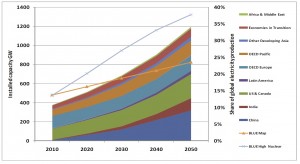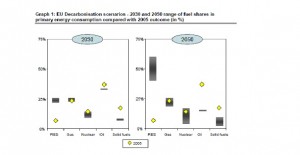What a difference a year makes! With New Build taking hold in the west in 2012 now is the time to sell the benefits of nuclear power to overcome the Fukushima effect.
The good news is that as 2011 comes to a close, Fukushima has achieved cold shutdown and the recovery is moving to the next stage. The emphasis is now on decontamination and getting the dislocated people back into their homes as soon as possible. Does this mean that nuclear will overcome the effects of Fukushima starting in 2012?
It was only a year ago that the International Energy Agency (“IEA”) issued its Nuclear Roadmap 2010. This report clearly demonstrates the important role that nuclear power can play in meeting climate change targets. With a 50% CO2 reduction targeted by 2050 in the so-called IEA Blue Map scenario, nuclear capacity triples and its share of electricity generation rises from 14% today to 24%, the largest of any generation technology. Under a postulated High Nuclear scenario, the nuclear share would reach as much as 38%!
IEA Nuclear Roadmap 2010 share of nuclear
But that was then and this is now. On March 11, as we all know, a devastating earthquake and tsunami struck Japan with horrific consequences – killing more than 20,000 and causing a nuclear accident at the Fukushima Daiichi Nuclear Plant. There was significant fuel melting in three units resulting in radioactive releases to the environment. Even though there have been no fatalities due to radiation and there is little risk of any future radiation health impacts, the global impact of this event to the nuclear industry was overwhelming. While many countries re-confirmed their commitment to nuclear power after reviewing plant safety and implementing lessons learned, some countries in Europe led by Germany have taken the decision to scale back or even move away from nuclear power.
In the IEA’s World Energy Outlook 2011 released in early November they added a new scenario – Low Nuclear – to account for a possible post-Fukushima shift away from nuclear power in addition to the New Policies (reference) and Current Policies scenarios. In the reference case, global nuclear power is expected to rise 70% by 2035 with China, Korea and India leading the growth. This case is only slightly less than the projection last year. In the new Low Nuclear Case, the total amount of nuclear capacity actually falls from 393 GW at the end of 2010 to 335 GW in 2035. According to the IEA, this scenario has severe implications for energy security, diversity of the fuel mix, spending on energy imports and energy-related CO2 emissions.
In this low nuclear scenario, by 2035, coal demand increases to over twice the level of Australia’s current steam coal exports. The increase in gas demand is equal to two-thirds of Russia’s natural gas exports in 2010. The increase in renewables-based generation is equal to almost five-times the current generation from renewables in Germany. Energy-related CO2 emissions also rise with increased use of fossil fuels in the power sector. This clearly has significant implications for global energy supply making it extraordinarily difficult to meet carbon targets. As stated in the IEA’s WEO report “Following this trajectory would depend on heroic achievements in the deployment of emerging low-carbon technologies, which have yet to be proven. Countries that rely heavily on nuclear power would find it particularly challenging and significantly more costly to meet their targeted levels of emissions.”
WEO New Policies (Reference) and Low Nuclear Scenarios nuclear capacities
And now, Europe has issued its Energy Roadmap 2050 with the overall emphasis on renewables and energy efficiency; a policy document that has been clearly impacted by the post Fukushima shift in thinking in Europe. As illustrated in the chart below, even with five different scenarios, the one thing they all have in common is a large increase in renewable energy generation. No other form of generation increases anywhere near to that of renewables; and in fact most other forms decline over the plan period with only the size of the decline depending upon the specific scenario. But even with this emphasis on renewables, the report does make important positive points on the role of nuclear power noting that nuclear energy is an important contributor to meeting the roadmap objectives.
In fact the report notes that today nuclear energy is the decarbonisation option providing most of the low-carbon electricity consumed in the EU. It then goes on to note the post Fukushima reality. “Some Member States consider the risks related to nuclear energy as unacceptable. Since the accident in Fukushima, public policy on nuclear energy has changed in some Member States while others continue to see nuclear energy as a secure, reliable and affordable source of low-carbon electricity generation.”
When it comes to cost, the impact is clear. Consistent with the IEA Nuclear Roadmap, this report states “the scenario analysis shows that nuclear energy contributes to lower system costs and electricity prices. As a large scale low-carbon option, nuclear energy will remain in the EU power generation mix.”
This is critical since the average capital costs of the energy system will increase significantly due to investments in power plants and grids, industrial energy equipment, heating and cooling systems, smart meters, insulation material, more efficient and low carbon vehicles, devices for exploiting local renewable energy sources (solar heat and photovoltaic), durable energy consuming goods etc. And the reality is that renewables are expensive with the highest electricity costs in the “near 100% RES power” scenario which the RES power generation capacity in 2050 would be more than twice as high as today’s total power generation capacity from all sources (I am assuming primarily due to the low capacity factors of renewable generation). Other scenarios such as the High Energy Efficiency scenario and the Diversified Supply Technology scenario have the lowest electricity prices due to somewhat lower renewable penetration (60 to 65%) taking advantage of the lower costs of efficiency, gas and nuclear. The report notes that many renewable technologies need further development to bring down costs.
So as we enter 2012, where does this leave us? One lesson from Fukushima is that many in the world are still very afraid of nuclear power because of the huge fear of radiation. There was an interesting piece on this in a CNN Health article this past week which argues that public trust in nuclear energy should be built on the existing acceptance of medical radiation dose levels. The public welcome moderate medical radiation levels from both internal and external sources, for medical imaging (CT, PET, SPECT scans) yet fear the much smaller levels from nuclear plants. And as I stated in my last blog entry, as an industry our work is cut out for us in changing this thinking. Reducing the public fear of radiation is no small task and will take time and a carefully coordinated approach from us all. Professor Wade Allison argues that the ALARA principle has hurt us and increases this fear of radiation and suggests that this policy should be replaced with “As High As Relatively Safe (AHARS)”, mindful of other dangers, local and global. An interesting approach indeed.
One thing is clear from the above IEA studies and the European Roadmap 2050. Reading between the lines nuclear power is essential to meeting long term carbon reduction goals. Relying too much on renewables is far too risky an approach and is more of a wishful thinking scenario than a realistic one. To achieve global carbon reduction objectives, it makes no sense to not take advantage of the one true large scale low carbon technology – nuclear power. It is here today – it is safe and in most jurisdictions it is economic.
So what about 2012? So far it looks like it can be a good year for nuclear power. Important progress in new build is being made in the UK; the US will see its first COLs enabling the first new builds to start construction in a generation; Canada may make a decision on its new build; and, of course China and others in Asia will continue to expand their programs.
Work in Japan will continue and will not be easy as the government works to decontaminate the area around Fukushima and hopefully many will get to return to their homes. Of importance we can expect to see many of the idled plants in Japan get approvals to restart easing the electricity shortage caused by these units not running. Again a recent Japanese study shows that nuclear remains the low cost option to 2030.
But of most importance, this is not time for industry complacency. This has to be the year where the industry marshals its forces to get the message out – in a thoughtful, clear, unambiguous way. The future is up to us so let’s get on with it and tell our story. Even though truth may be on our side, the path is going to be long and the work hard……..but in the end it is worth it for us all………
We offer a proven large scale clean, economic and, of utmost importance, safe option for electricity generation. As the only proven large scale low carbon option that can meet the world’s energy needs, nuclear power must continue to be an important part of the electricity generation mix now and into the future.


